Life Cycle Assessment of Ordinary Portland Cement Production in South Africa: Mid-Point and End-Point Approaches
Abstract
1. Introduction
2. Literature Review
2.1. Cement in the Sub-Saharan Africa (SSA) Region
2.2. Overview of Existing Studies
| Reference | Aim | Country | Themes | Findings | ||
|---|---|---|---|---|---|---|
| LCIA Approach | Sensitivity Analysis | Damage to Human Health | ||||
| (Meshram and Kumar, 2022) | To conduct a life cycle assessment (LCA) of two types of geopolymer cement and compare it to traditional Portland cement in an Indian context. | India | Cradle-to-gate life cycle assessment following ISO 14040 principles. | Not considered | Not considered | Geopolymer cement based on fly ash and blast furnace slag reduces global warming potential by 70%, abiotic depletion potential fossil by 49%, abiotic depletion potential element by 34%, and terrestrial ecotoxicity potential by 77% compared to ordinary Portland cement. |
| (Morsali, 2016) | To analyze the life cycle impacts of Portland cement production on human health, ecosystem quality, and resource depletion using LCA methodology. | Western Europe | Life cycle assessment using SimaPro software and Eco-Indicator 99 methodology. | Not considered | Not considered | The cement production process and coal tailings landfilling caused the most damage to human health. Crude oil and coal mining were the biggest contributors to resource depletion. Cement production, uranium mining, and transportation caused the most damage to ecosystem quality. The key emissions contributing to impacts were CO₂, NOx, SOx, CH4, and metals like Ni, Zn, Cr, As, and Cd. |
| (Nigri et al., 2010) | Apply life cycle assessment (LCA) to evaluate environmental impacts of Portland cement manufacturing. | Brazil | Life cycle assessment based on ISO 14040 principles. | Not considered | Not considered | Cement production causes environmental impacts, including greenhouse gas emissions, air pollution, and waste generation. |
| (Li et al., 2015) | Evaluate the environmental impacts of cement production in China and identify potential improvements. | China | Life cycle assessment, comparative analysis. | Not considered | Not considered | The study finds China has higher emissions except for CO₂ compared to Japan due to less advanced technologies. |
| (Stafford, Raupp-Pereira, et al., 2016) | To analyze the environmental impacts of cement production at a Brazilian cement plant through life cycle assessment (LCA). | Brazil | Life cycle assessment guided by ISO 14040 and ISO 14044. | Not considered | Not considered | Transportation had the largest contribution to most environmental impact categories. After transportation, fossil fuel production and the cement kiln were the major contributors. |
| (Stafford, Dias, et al., 2016) | Assess the environmental impacts of using wastes as fuel in cement manufacturing in a plant in southern Europe. | Portugal | Life cycle assessment based on primary data from the cement plant and secondary data from the Ecoinvent database. | Not considered | Not considered | Atmospheric emissions from the kiln were the main contributor to most impact categories except abiotic depletion. Using alternative fuels like refuse-derived fuel and scrap tires reduced impacts compared to studies using only fossil fuels. |
| (Bushi and Meil, 2014) | To quantify the environmental impacts of Portland limestone cement (PLC) compared to ordinary Portland cement (OPC) using life cycle assessment. | Canada | Cradle-to-gate life cycle assessment of cement and concrete mixes following ISO standards. | Not considered | Not considered | PLC has 9–12% lower environmental impacts than OPC across all indicators studied. PLC concrete mixes have 7–9% lower impacts than OPC. Reducing clinker content in cement through PLC reduces energy use and emissions. |
| (Tun et al., 2020) | To evaluate the environmental impacts of cement production in Myanmar using life cycle assessment (LCA) and identify key contributors to impacts. | Myanmar | Life cycle assessment following ISO standards, using site-specific data from eight cement plants in Myanmar. | Not considered | Not considered | Major impacts, including climate change, photochemical oxidant formation, particulate matter formation, terrestrial acidification, and fossil resource scarcity, were observed. The main contributors to these impacts were CO₂, NOx, SO2, and PM2.5 emissions from clinker production and fossil fuel use. Among the various damage categories, human health emerged as the most affected. |
| (Huntzinger and Eatmon, 2009) | Assess the environmental impacts of four cement manufacturing processes: traditional Portland cement, blended cement with natural pozzolans, cement production with CO₂ sequestration in cement kiln dust (CKD), and cement production with CKD recycling [27]. | United States | Life cycle assessment using SimaPro software to model the environmental impacts of different cement production processes. The functional unit of analysis was the production of 1 ton of cement. | Not considered | Not considered | Blended cement with natural pozzolans had the lowest global warming potential. Carbon sequestration in CKD reduced global warming potential by about 5% compared to traditional Portland cement. |
| Present study | To conduct a life cycle assessment of the environmental impacts of cement production in a typical South African plant. | South Africa | Life cycle assessment using mid-point and end-point approaches on 1 kg of cement produced. | Considered | Considered | To be presented in the discussion section. |
2.3. Contributions to Knowledge
3. Methods
3.1. Goal and Scope Definition
3.2. Life Cycle Inventory
3.3. Life Cycle Impact Assessment
3.4. Interpretation
4. Results and Discussions
4.1. Mid-Point Analysis (Process-Oriented Approach)
4.1.1. Clinker Production
4.1.2. Raw Material Consumption
4.1.3. Electricity Usage
4.1.4. Fuel Consumption
4.1.5. Transportation
4.1.6. Ozone Formation
4.1.7. Toxicity
4.1.8. Global Warming
4.1.9. Fossil Resource Scarcity
4.2. End-Point Analysis (Damage-Oriented Approach)
4.2.1. Clinker Production
4.2.2. Raw Material Consumption
4.2.3. Electricity Usage
4.2.4. Fuel Consumption
4.2.5. Transportation
4.2.6. Human Health
4.2.7. Ecosystem
4.2.8. Resources
4.3. Uncertainty Analysis Result
4.4. Discussion of Results
4.5. Comparison with Previous Studies
5. Conclusions, Recommendations, and Future Research
5.1. Contribution and Practical Implications
5.2. Recommendations and Future Research
Supplementary Materials
Author Contributions
Funding
Institutional Review Board Statement
Informed Consent Statement
Data Availability Statement
Conflicts of Interest
References
- Franzoni, E. Materials selection for green buildings: Which tools for engineers and architects? Procedia Eng. 2011, 21, 883–890. [Google Scholar] [CrossRef]
- Garside, M. Major Countries in Worldwide Cement Production 2015–2019; Datis export group: Tehran, Iran, 2020. [Google Scholar]
- Madlool, N.; Saidur, R.; Rahim, N.; Islam, M.; Hossian, M. An exergy analysis for cement industries: An overview. Renew. Sustain. Energy Rev. 2012, 16, 921–932. [Google Scholar] [CrossRef]
- Taylor, M.; Tam, C.; Gielen, D. Energy efficiency and CO2 emissions from the global cement industry. Korea 2006, 50, 61–67. [Google Scholar]
- Rodgers, L. Climate change: The massive CO2 emitter you may not know about. BBC News 2018, 17, 2018. [Google Scholar]
- Stafford, F.N.; Raupp-Pereira, F.; Labrincha, J.A.; Hotza, D. Life cycle assessment of the production of cement: A Brazilian case study. J. Clean. Prod. 2016, 137, 1293–1299. [Google Scholar] [CrossRef]
- Moretti, L.; Caro, S. Critical analysis of the life cycle assessment of the Italian cement industry. J. Clean. Prod. 2017, 152, 198–210. [Google Scholar] [CrossRef]
- Muigai, R.; Alexander, M.; Moyo, P. Cradle-to-gate environmental impacts of the concrete industry in South Africa. J. S. Afr. Inst. Civ. Eng. J. Van Suid-Afr. Inst. Van Siviele Ingenieurswese 2014, 56, 108. [Google Scholar]
- Bekun, F.V.; Emir, F.; Sarkodie, S.A. Another look at the relationship between energy consumption, carbon dioxide emissions, and economic growth in South Africa. Sci. Total Environ. 2019, 655, 759–765. [Google Scholar] [CrossRef] [PubMed]
- Ige, O.E.; Olanrewaju, O.A. Comparative Life Cycle Assessment of Different Portland Cement Types in South Africa. Clean Technol. 2023, 5, 901–920. [Google Scholar] [CrossRef]
- Ige, O.E.; Duffy, K.J.; Olanrewaju, O.A.; Collins, O.C. An Integrated System Dynamics Model and Life Cycle Assessment for Cement Production in South Africa. Atmosphere 2022, 13, 1788. [Google Scholar] [CrossRef]
- Thwe, E.; Khatiwada, D.; Gasparatos, A. Life cycle assessment of a cement plant in Naypyitaw, Myanmar. Clean. Environ. Syst. 2021, 2, 100007. [Google Scholar] [CrossRef]
- Asadollahfardi, G.; Katebi, A.; Taherian, P.; Panahandeh, A. Environmental life cycle assessment of concrete with different mixed designs. Int. J. Constr. Manag. 2021, 21, 665–676. [Google Scholar] [CrossRef]
- Suárez, S.; Roca, X.; Gasso, S. Product-specific life cycle assessment of recycled gypsum as a replacement for natural gypsum in ordinary Portland cement: Application to the Spanish context. J. Clean. Prod. 2016, 117, 150–159. [Google Scholar] [CrossRef]
- Stafford, F.N.; Dias, A.C.; Arroja, L.; Labrincha, J.A.; Hotza, D. Life cycle assessment of the production of Portland cement: A Southern Europe case study. J. Clean. Prod. 2016, 126, 159–165. [Google Scholar] [CrossRef]
- Eros, J.; Candelario-Quintana, L. Mineral Facilities of Africa and the Middle East; US Geological Survey Open-File Report; Unites State Geological Survey (USGS): Washington, DC, USA, 2006; Volume 1135. [Google Scholar]
- Cement, W. Middle Africa’s Cement Sector: Explosive Growth. Ecobank2014. Available online: https://www.worldcement.com/africa-middle-east/30072014/middle-africa-cement-sector-explosive-growth-205/ (accessed on 10 March 2020).
- Bank, T.W. Cement Sectore Program in Sub-Saharan Africa: Barriers Analysis to CDM and Solutions; Final Report; Carbon Finance Assistance: Québec, Canada, 2009. [Google Scholar]
- Aecom. The blue book. In Property and Construction Handbook; Aecom—Architecture, Engineering, Construction, Operations, and Management: Dallas, TX, USA, 2014; Available online: https://aecom.com/bh/wp-content/uploads/2019/07/Construction-Handbook-2018_update-1907-LR-2.pdf (accessed on 24 April 2021).
- Zengeni, T.; Mondliwa, P. Consolidation and Entry: Changing Dynamics in the Regional Cement; Quarterly review; University of Johannesburg: Johannesburg, South Africa, 2015. [Google Scholar]
- Meshram, R.; Kumar, S. Comparative life cycle assessment (LCA) of geopolymer cement manufacturing with Portland cement in Indian context. Int. J. Environ. Sci. Technol. 2022, 19, 4791–4802. [Google Scholar] [CrossRef]
- Morsali, S. Emissions from portland cement production using life cycle assessment inventory and method. Environ. Energy Econ. 2016, 1, 1–8. [Google Scholar]
- Nigri, E.M.; Rocha, S.D.F.; Filho, E.R. Portland cement: An application of life cycle assessment. Prod. Manag. Dev. 2010, 8, 167–172. [Google Scholar]
- Li, C.; Cui, S.; Nie, Z.; Gong, X.; Wang, Z.; Itsubo, N. The LCA of Portland cement production in China. Int. J. Life Cycle Assess. 2015, 20, 117–127. [Google Scholar] [CrossRef]
- Bushi, L.; Meil, J. An environmental life cycle assessment of portland-limestone and ordinary portland cements in concrete. Cem. Assoc. Can. 2014, 10, 1–10. [Google Scholar]
- Tun, T.Z.; Bonnet, S.; Gheewala, S.H. Life cycle assessment of Portland cement production in Myanmar. Int. J. Life Cycle Assess. 2020, 25, 2106–2121. [Google Scholar] [CrossRef]
- Huntzinger, D.N.; Eatmon, T.D. A life-cycle assessment of Portland cement manufacturing: Comparing the traditional process with alternative technologies. J. Clean. Prod. 2009, 17, 668–675. [Google Scholar] [CrossRef]
- ISO 14044:2006; Environmental Management—Life Cycle Assessment—Requirements and Guidelines. ISO: Geneva, Switzerland, 2006.
- ISO 14040:1997; Environmental Management: Life Cycle Assessment: Principles and Framework. ISO: Geneva, Switzerland, 1997.
- ISO 14040:2006; Environmental Management: Life Cycle Assessment; Principles and Framework (no. 2006). ISO: Geneva, Switzerland, 2006.
- Young, S.B.; Turnbull, S.; Russell, A. Substudy 6: What LCA Can Tell Us about the Cement Industry; Citeseer: Raleigh, NC, USA, 2002. [Google Scholar]
- Goedkoop, M.; Heijungs, R.; Huijbregts, M.; De Schryver, A.; Struijs, J.; Van Zelm, R. ReCiPe 2008. In A Life Cycle Impact Assessment Method which Comprises Harmonised Category Indicators at the Midpoint and the Endpoint Level; Ministry of VROM: The Hague, The Netherlands, 2009; Volume 1, pp. 1–126. [Google Scholar]
- Bare, J.C. TRACI: The tool for the reduction and assessment of chemical and other environmental impacts. J. Ind. Ecol. 2002, 6, 49–78. [Google Scholar] [CrossRef]
- Filimonau, V.; Dickinson, J.; Robbins, D.; Huijbregts, M.A. Reviewing the carbon footprint analysis of hotels: Life Cycle Energy Analysis (LCEA) as a holistic method for carbon impact appraisal of tourist accommodation. J. Clean. Prod. 2011, 19, 1917–1930. [Google Scholar] [CrossRef]
- Bare, J.; Young, D.; Qam, S.; Hopton, M.; Chief, S. Tool for the Reduction and Assessment of Chemical and other Environmental Impacts (TRACI); US Environmental Protection Agency: Washington, DC, USA, 2012. [Google Scholar]
- Finkbeiner, M.; Inaba, A.; Tan, R.; Christiansen, K.; Klüppel, H.-J. The new international standards for life cycle assessment: ISO 14040 and ISO 14044. Int. J. Life Cycle Assess. 2006, 11, 80–85. [Google Scholar] [CrossRef]
- Hoffman, L.; Schmidt, A. Life Cycle Assessment. A guide to approaches, experiences and information sources. Man. Environ. Qual. Int. J. 1997, 17, 490–507. [Google Scholar]
- Marinković, S. Life cycle assessment (LCA) aspects of concrete. In Eco-Efficient Concrete; Elsevier: Amsterdam, The Netherlands, 2013; pp. 45–80. [Google Scholar]
- Marinković, S.; Dragaš, J.; Ignjatović, I.; Tošić, N. Environmental assessment of green concretes for structural use. J. Clean. Prod. 2017, 154, 633–649. [Google Scholar] [CrossRef]
- Kabir, G.; Abubakar, A.; El-Nafaty, U. Energy audit and conservation opportunities for pyroprocessing unit of a typical dry process cement plant. Energy 2010, 35, 1237–1243. [Google Scholar] [CrossRef]
- Ailleret, F. Comparison of Energy Systems Using Life Cycle Assessment; World Energy Council: London, UK, 2004; Volume 2, p. 3.1. [Google Scholar]
- Pacheco-Torgal, F.; Cabeza, L.F.; Labrincha, J.; De Magalhaes, A.G. Eco-Efficient Construction and Building Materials: Life Cycle Assessment (LCA), Eco-Labelling and Case Studies; Woodhead Publishing: Cambridge, UK, 2014. [Google Scholar]
- García-Gusano, D.; Herrera, I.; Garraín, D.; Lechón, Y.; Cabal, H. Life cycle assessment of the Spanish cement industry: Implementation of environmental-friendly solutions. Clean Technol. Environ. Policy 2015, 17, 59–73. [Google Scholar] [CrossRef]
- Vázquez-Rowe, I.; Ziegler-Rodriguez, K.; Laso, J.; Quispe, I.; Aldaco, R.; Kahhat, R. Production of cement in Peru: Understanding carbon-related environmental impacts and their policy implications. Resour. Conserv. Recycl. 2019, 142, 283–292. [Google Scholar] [CrossRef]
- Palermo, G.C.; Castelo Branco, D.A.; Fiorini, A.C.O.; De Freitas, M.A.V. Comparative life cycle assessment of three 2030 scenarios of the Brazilian cement industry. Environ. Monit. Assess. 2022, 194, 153. [Google Scholar] [CrossRef]
- Çankaya, S.; Pekey, B. A comparative life cycle assessment for sustainable cement production in Turkey. J. Environ. Manag. 2019, 249, 109362. [Google Scholar] [CrossRef] [PubMed]
- Nuvolone, D.; Petri, D.; Voller, F. The effects of ozone on human health. Environ. Sci. Pollut. Res. 2018, 25, 8074–8088. [Google Scholar] [CrossRef]
- Sharma, S.B.; Jain, S.; Khirwadkar, P.; Kulkarni, S. The effects of air pollution on the environment and human health. Indian J. Res. Pharm. Biotechnol. 2013, 1, 391–396. [Google Scholar]
- Theodorakidou, M.; Lambrou, G.I. Public health issues from the exposure to nitrogen oxides: A brief review. ARC J. Public Health Community Med. 2017, 2, 44–56. [Google Scholar]
- Nataraja, M.; Das, L. Concrete mix proportioning as per IS 10262: 2009–Comparison with IS 10262: 1982 and ACI 211.1-91. Indian Concr. J. 2010, 84, 64–70. [Google Scholar]
- Goel, N. Design Mix Concrete-Economy & Environmental Isuues; Central Vigilance Commission: New Delhi, India, 2011. [Google Scholar]
- Kumar, P. M20 Grade Concrete Mix Design–IS10262 Latest Edition. Civil Research and Development. 2021. Available online: https://civilrnd.com/m20-grade-concrete-mix-design-is10262-latest-edition/ (accessed on 24 April 2021).
- Gagg, C.R. Cement and concrete as an engineering material: An historic appraisal and case study analysis. Eng. Fail. Anal. 2014, 40, 114–140. [Google Scholar] [CrossRef]
- Martínez-Rocamora, A.; Solís-Guzmán, J.; Marrero, M. LCA databases focused on construction materials: A review. Renew. Sustain. Energy Rev. 2016, 58, 565–573. [Google Scholar] [CrossRef]
- Jacobson, T.A.; Kler, J.S.; Hernke, M.T.; Braun, R.K.; Meyer, K.C.; Funk, W.E. Direct human health risks of increased atmospheric carbon dioxide. Nat. Sustain. 2019, 2, 691–701. [Google Scholar] [CrossRef]
- Mann, M.E.; Bradley, R.S.; Hughes, M.K. Global-scale temperature patterns and climate forcing over the past six centuries. Nature 1998, 392, 779–787. [Google Scholar] [CrossRef]
- Alley, R.; Berntsen, T.; Bindoff, N.L.; Chen, Z.; Chidthaisong, A.; Friedlingstein, P.; Gregory, J.; Hegerl, G.; Heimann, M.; Hewitson, B. Climate change 2007: The physical science basis. In Contribution of Working Group I to the Fourth Assessment Report of the Intergovernmental Panel on Climate Change. Summary for Policymakers; IPCC Secretariat: Geneva, Switzerland, 2008; p. 21. [Google Scholar]
- Worldometer. South Africa Population 2021. Available online: www.worldometers.info/world-population/south-africa-population/ (accessed on 10 May 2021).
- Valderrama, C.; Granados, R.; Cortina, J.L.; Gasol, C.M.; Guillem, M.; Josa, A. Implementation of best available techniques in cement manufacturing: A life-cycle assessment study. J. Clean. Prod. 2012, 25, 60–67. [Google Scholar] [CrossRef]
- García-Gusano, D.; Garraín, D.; Herrera, I.; Cabal, H.; Lechón, Y. Life Cycle Assessment of applying CO2 post-combustion capture to the Spanish cement production. J. Clean. Prod. 2015, 104, 328–338. [Google Scholar] [CrossRef]
- Georgiopoulou, M.; Lyberatos, G. Life cycle assessment of the use of alternative fuels in cement kilns: A case study. J. Environ. Manag. 2018, 216, 224–234. [Google Scholar] [CrossRef] [PubMed]
- Bosoaga, A.; Masek, O.; Oakey, J.E. CO₂ capture technologies for cement industry. Energy Procedia 2009, 1, 133–140. [Google Scholar] [CrossRef]
- Bacatelo, M.; Capucha, F.; Ferrao, P.; Margarido, F. Selection of a CO₂ capture technology for the cement industry: An integrated TEA and LCA methodological framework. J. CO₂ Util. 2023, 68, 102375. [Google Scholar] [CrossRef]
- Guo, Y.; Luo, L.; Liu, T.; Hao, L.; Li, Y.; Liu, P.; Zhu, T. A review of low-carbon technologies and projects for the global cement industry. J. Environ. Sci. 2023, 136, 682–697. [Google Scholar] [CrossRef]
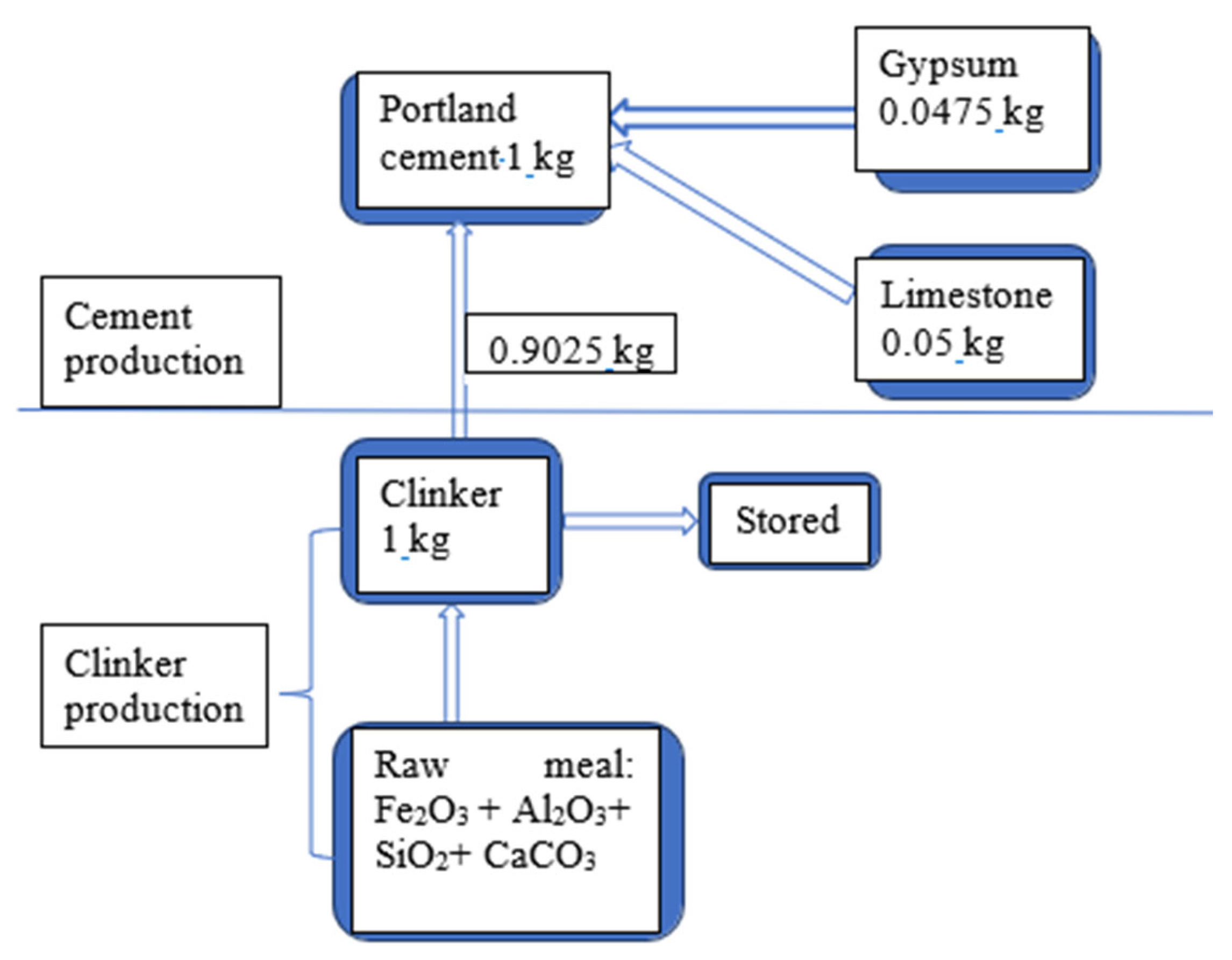
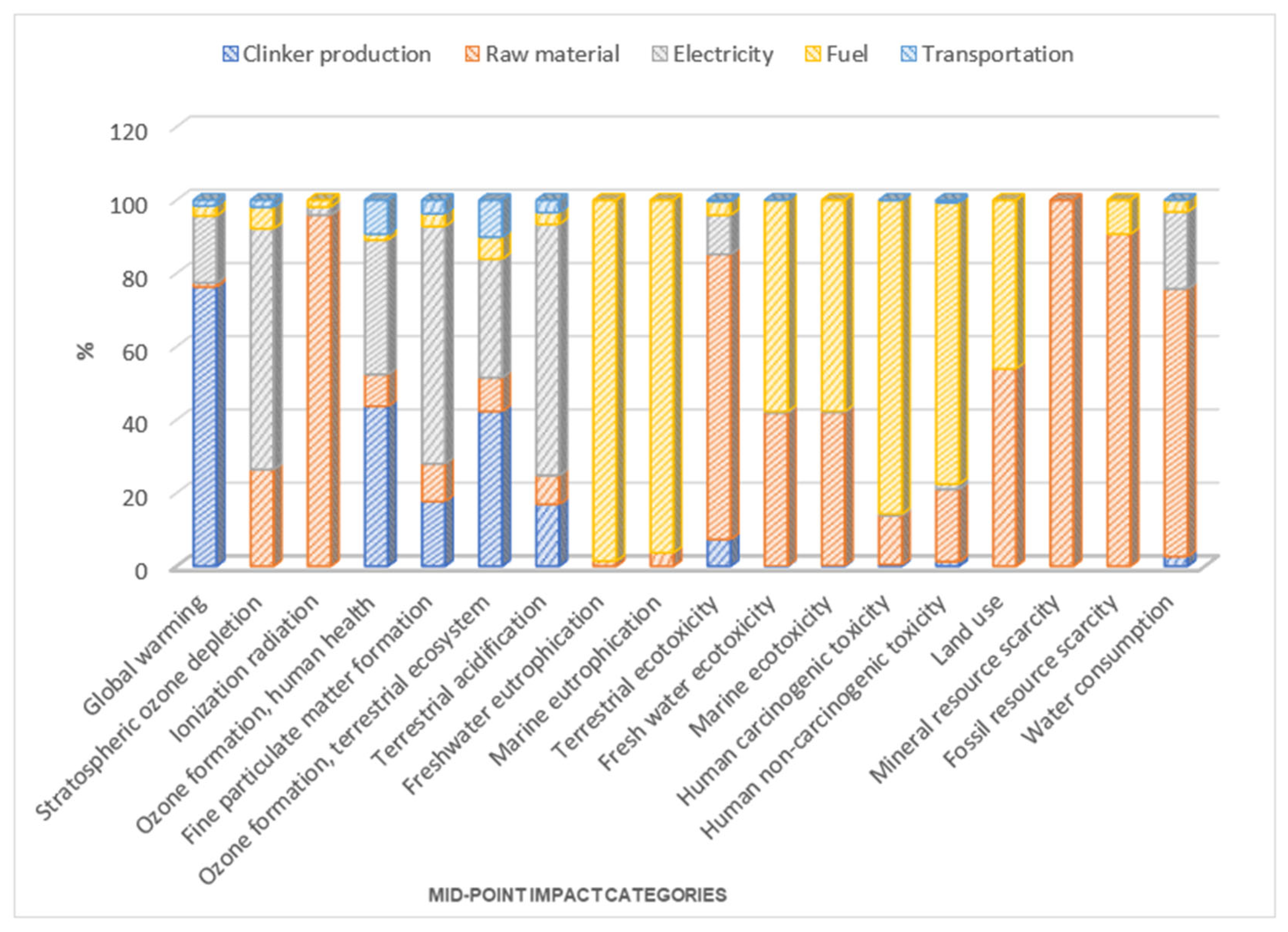


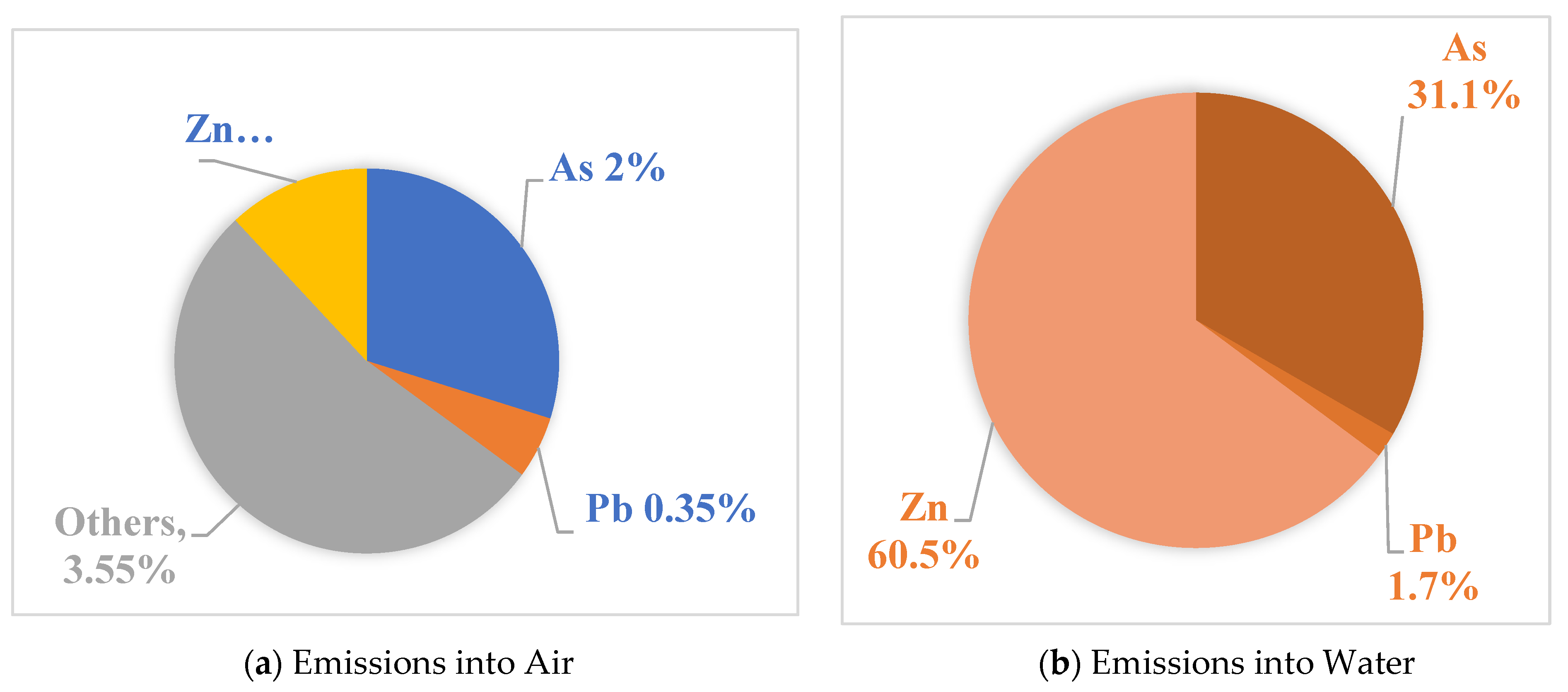
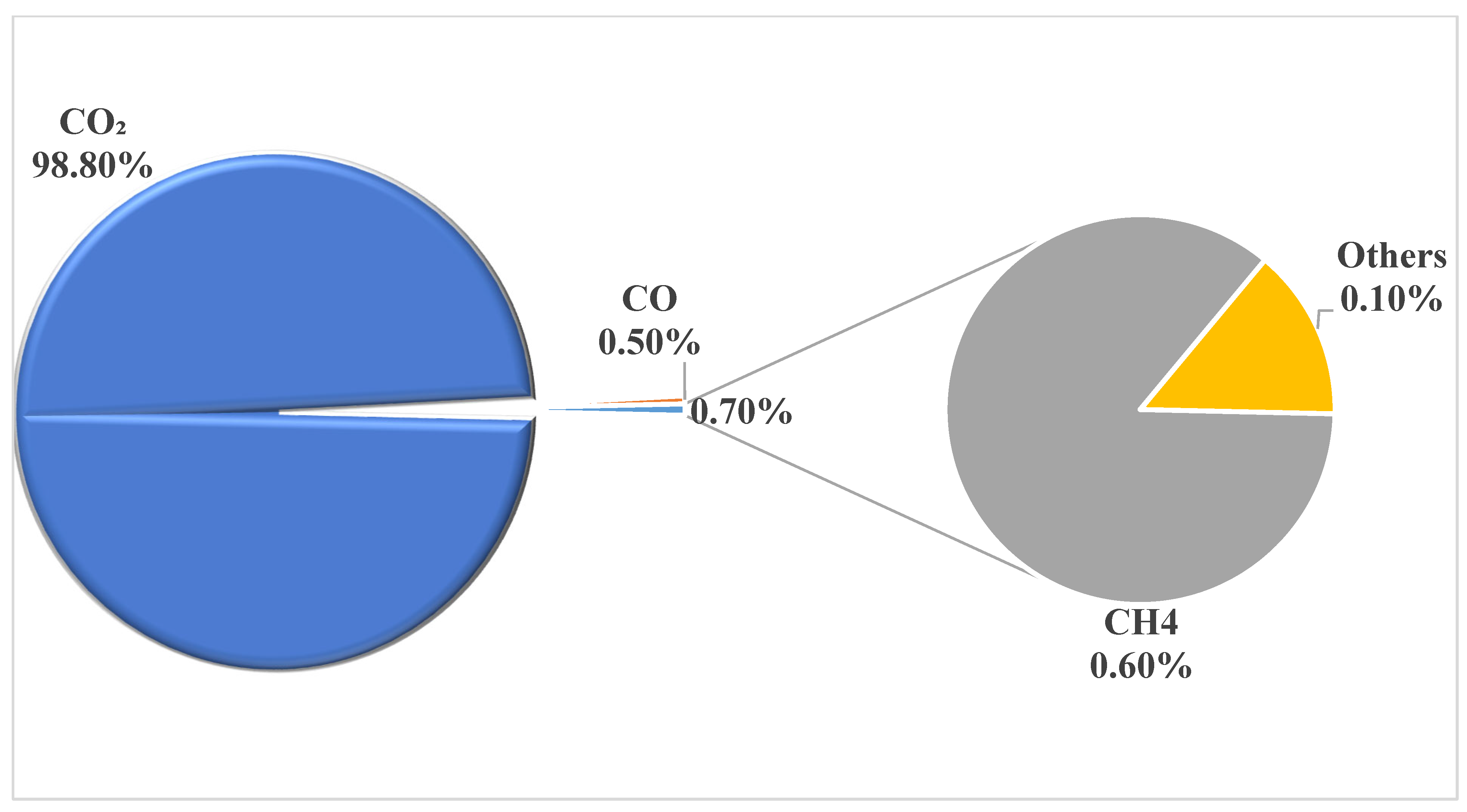
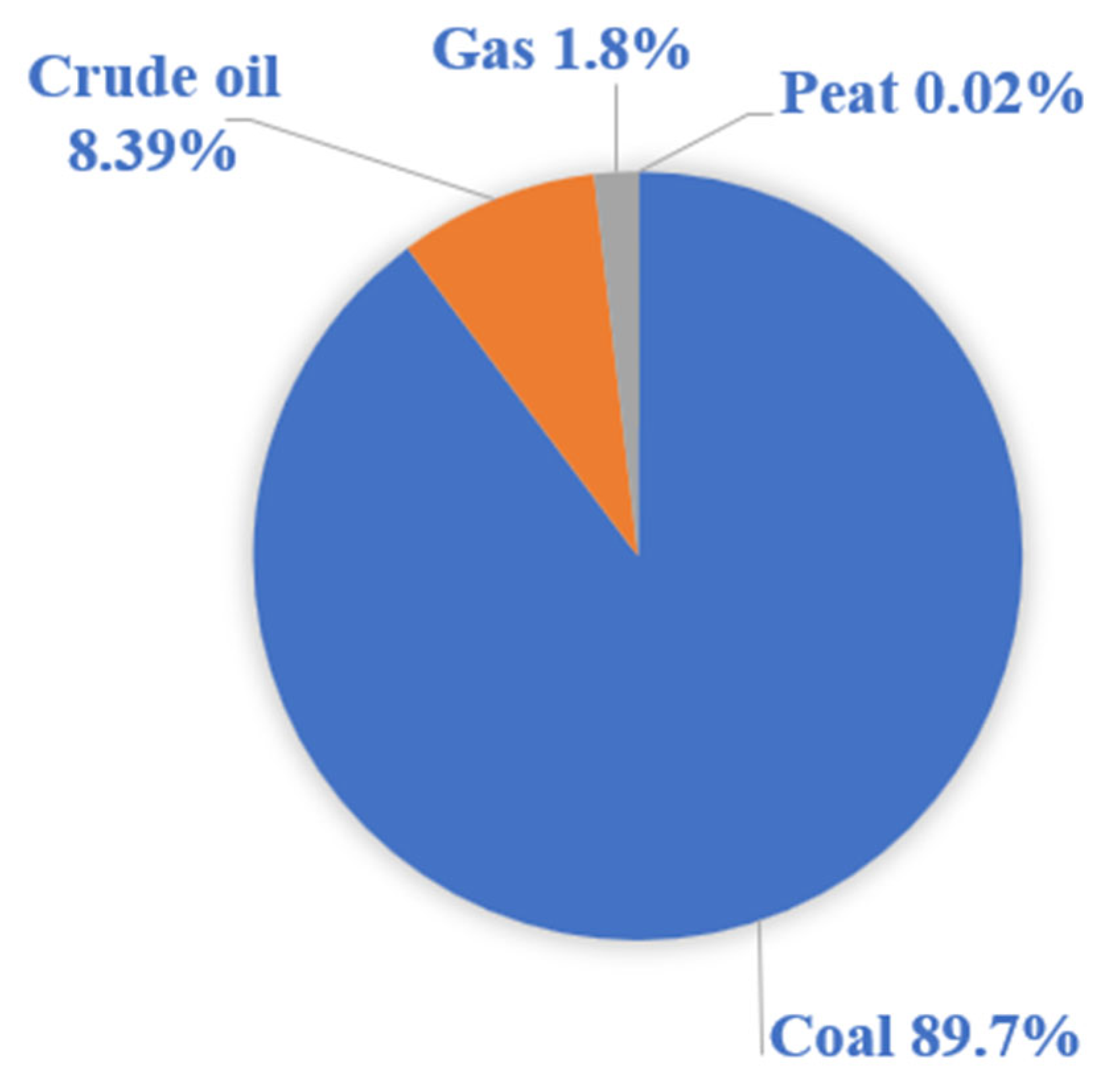


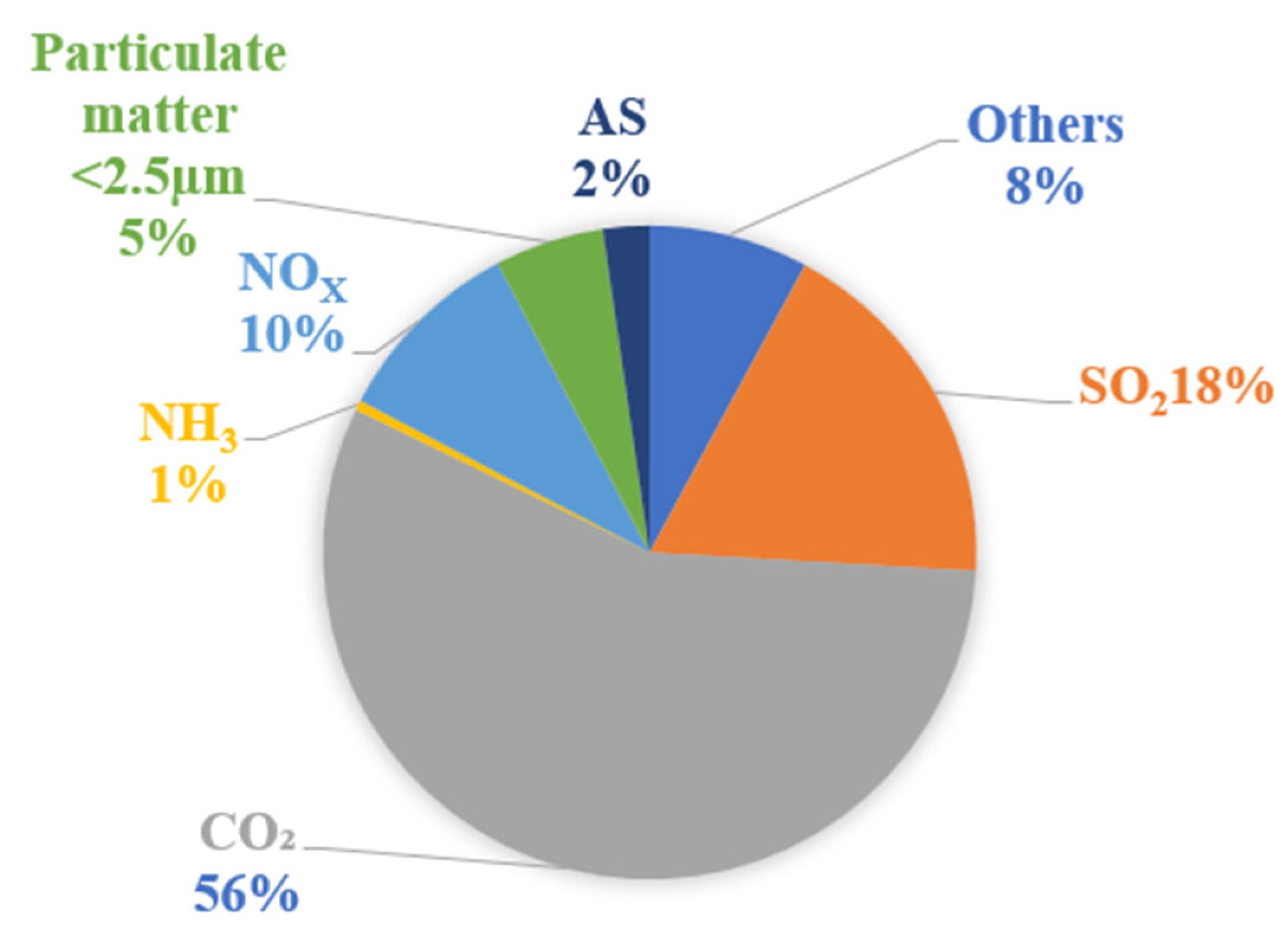


| Company | Production Capacity (MTs) | Countries of Operation in SSA |
|---|---|---|
| Dangote cement | 20.7 | Nigeria, Benin, Cameroon, Senegal, Cote d’Ivoire, Sierra Leon, Liberia, Ghana, Congo- Brazzaville, Ethiopia, Kenya, Tanzania, Zambia, South Africa |
| Lafarge | 19.5 | Nigeria, Benin, Cameroon, Kenya, Tanzania, Zambia, South Africa, Uganda, Malawi, Mozambique, Botswana, Zimbabwe |
| PPC | 18.0 | South Africa, Zimbabwe, Botswana |
| Heigelberg | 6.7 | Sierra Leon, Liberia, Ghana, Tanzania, Benin, Gabon, Togo |
| AfriSam | 5.8 | South Africa, Lesotho, Botswana, Tanzania, Swaziland |
| ARM cement | 5.5 | Tanzania, South Africa, Kenya, Rwanda |
| Sococim | 4.2 | Senegal |
| Holcim | 3.0 | Nigeria, Cote d’Ivoire, Morocco, Tanzania, South Africa, Guinea |
| Derba Midroc Cement | 2.5 | Ethiopia |
| WACEM | 2.0 | Ghana, Togo |
| Region | No. of Plants | Production Capacity (tons) | Actual Production (tons) | Capacity Utilization |
|---|---|---|---|---|
| West Africa | 29 | 19,241,000 | 8,779,130 | 46% |
| Central Africa | 11 | 3,613,000 | 1,720,000 | 48% |
| East Africa | 29 | 8,954,000 | 6,768,110 | 76% |
| Southern Africa | 6 | 13,145,000 | 12,348,000 | 94% |
| Total | 75 | 44,953,000 | 29,615,240 | 66% |
| S/N | Impact Category | Unit | Value |
|---|---|---|---|
| 1 | Global warming | kg CO₂ eq | 0.993 |
| 2 | Stratospheric ozone depletion | kg CFC11 eq | 1.94 × 10−7 |
| 3 | Ionization radiation | kBq Co-60 eq | 0.00997 |
| 4 | Ozone formation, human health | kg NOx eq | 0.0021 |
| 5 | Fine particulate matter formation | kg PM2.5 eq | 0.000793 |
| 6 | Ozone formation, terrestrial ecosystem | kg NOx eq | 0.00212 |
| 7 | Terrestrial acidification | kg SO2 eq | 0.00244 |
| 8 | Freshwater eutrophication | kg P eq | 0.000316 |
| 9 | Marine eutrophication | kg N eq | 1.93 × 10−5 |
| 10 | Terrestrial ecotoxicity | kg 1,4-DCB eq | 1.04 |
| 11 | Freshwater ecotoxicity | kg 1,4-DCB eq | 0.0158 |
| 12 | Marine ecotoxicity | kg 1,4-DCB eq | 0.0214 |
| 13 | Human carcinogenic toxicity | kg 1,4-DCB eq | 0.0244 |
| 14 | Human non-carcinogenic toxicity | kg 1,4-DCB eq | 0.497 |
| 15 | Land use | m2a crop eq | 0.00783 |
| 16 | Mineral resource scarcity | kg Cu eq | 0.00216 |
| 17 | Fossil resource scarcity | kg oil eq | 0.139 |
| 18 | Water consumption | m3 | 0.00136 |
| S/N | Impact Category | Unit | Value |
|---|---|---|---|
| 1 | Global warming, human health | DALY | 9.21 × 10−7 |
| 2 | Stratospheric ozone depletion | DALY | 1.03 × 10−10 |
| 3 | Ionizing radiation | DALY | 8.46 × 10−11 |
| 4 | Water consumption, human health | DALY | 1.50 × 10−9 |
| 5 | Ozone formation, human health | DALY | 1.91 × 10−9 |
| 6 | Fine particulate formation | DALY | 4.98 × 10−7 |
| 7 | Human carcinogenic toxicity | DALY | 8.10 × 10−8 |
| 8 | Human non-carcinogenic toxicity | DALY | 1.13 × 10−7 |
| 9 | Global warming, terrestrial ecosystems | Species/yr | 2.78 × 10−9 |
| 10 | Global warming, freshwater ecosystems | Species/yr | 7.60 × 10−14 |
| 11 | Ozone formation, terrestrial ecosystems | Species/yr | 2.73 × 10−10 |
| 12 | Terrestrial acidification | Species/yr | 5.18 × 10−10 |
| 13 | Freshwater eutrophication | Species/yr | 2.12 × 10−10 |
| 14 | Marine eutrophication | Species/yr | 3.29 × 10−14 |
| 15 | Terrestrial ecotoxicity | Species/yr | 1.19 × 10−11 |
| 16 | Freshwater ecotoxicity | Species/yr | 1.09 × 10−11 |
| 17 | Marine ecotoxicity | Species/yr | 2.25 × 10−12 |
| 18 | Land use | Species/yr | 6.95 × 10−11 |
| 19 | Water consumption, terrestrial ecosystems | Species/yr | 2.01 × 10−10 |
| 20 | Water consumption, aquatic ecosystems | Species/yr | 2.14 × 10−15 |
| 21 | Mineral resource scarcity | USD2013 | 5.00 × 10−4 |
| 22 | Fossil resource scarcity | USD2013 | 1.64 × 10−2 |
| S/N | Damage Category | Unit | Value |
|---|---|---|---|
| 1 | Human health | DALY | 1.62 × 10−6 |
| 2 | Ecosystems | Species/yr | 3.90 × 10−9 |
| 3 | Resources | USD2013 | 0.0169 |
Disclaimer/Publisher’s Note: The statements, opinions and data contained in all publications are solely those of the individual author(s) and contributor(s) and not of MDPI and/or the editor(s). MDPI and/or the editor(s) disclaim responsibility for any injury to people or property resulting from any ideas, methods, instructions or products referred to in the content. |
© 2024 by the authors. Licensee MDPI, Basel, Switzerland. This article is an open access article distributed under the terms and conditions of the Creative Commons Attribution (CC BY) license (https://creativecommons.org/licenses/by/4.0/).
Share and Cite
Akintayo, B.D.; Olanrewaju, O.A.; Olanrewaju, O.I. Life Cycle Assessment of Ordinary Portland Cement Production in South Africa: Mid-Point and End-Point Approaches. Sustainability 2024, 16, 3001. https://doi.org/10.3390/su16073001
Akintayo BD, Olanrewaju OA, Olanrewaju OI. Life Cycle Assessment of Ordinary Portland Cement Production in South Africa: Mid-Point and End-Point Approaches. Sustainability. 2024; 16(7):3001. https://doi.org/10.3390/su16073001
Chicago/Turabian StyleAkintayo, Busola Dorcas, Oludolapo Akanni Olanrewaju, and Oludolapo Ibrahim Olanrewaju. 2024. "Life Cycle Assessment of Ordinary Portland Cement Production in South Africa: Mid-Point and End-Point Approaches" Sustainability 16, no. 7: 3001. https://doi.org/10.3390/su16073001
APA StyleAkintayo, B. D., Olanrewaju, O. A., & Olanrewaju, O. I. (2024). Life Cycle Assessment of Ordinary Portland Cement Production in South Africa: Mid-Point and End-Point Approaches. Sustainability, 16(7), 3001. https://doi.org/10.3390/su16073001








